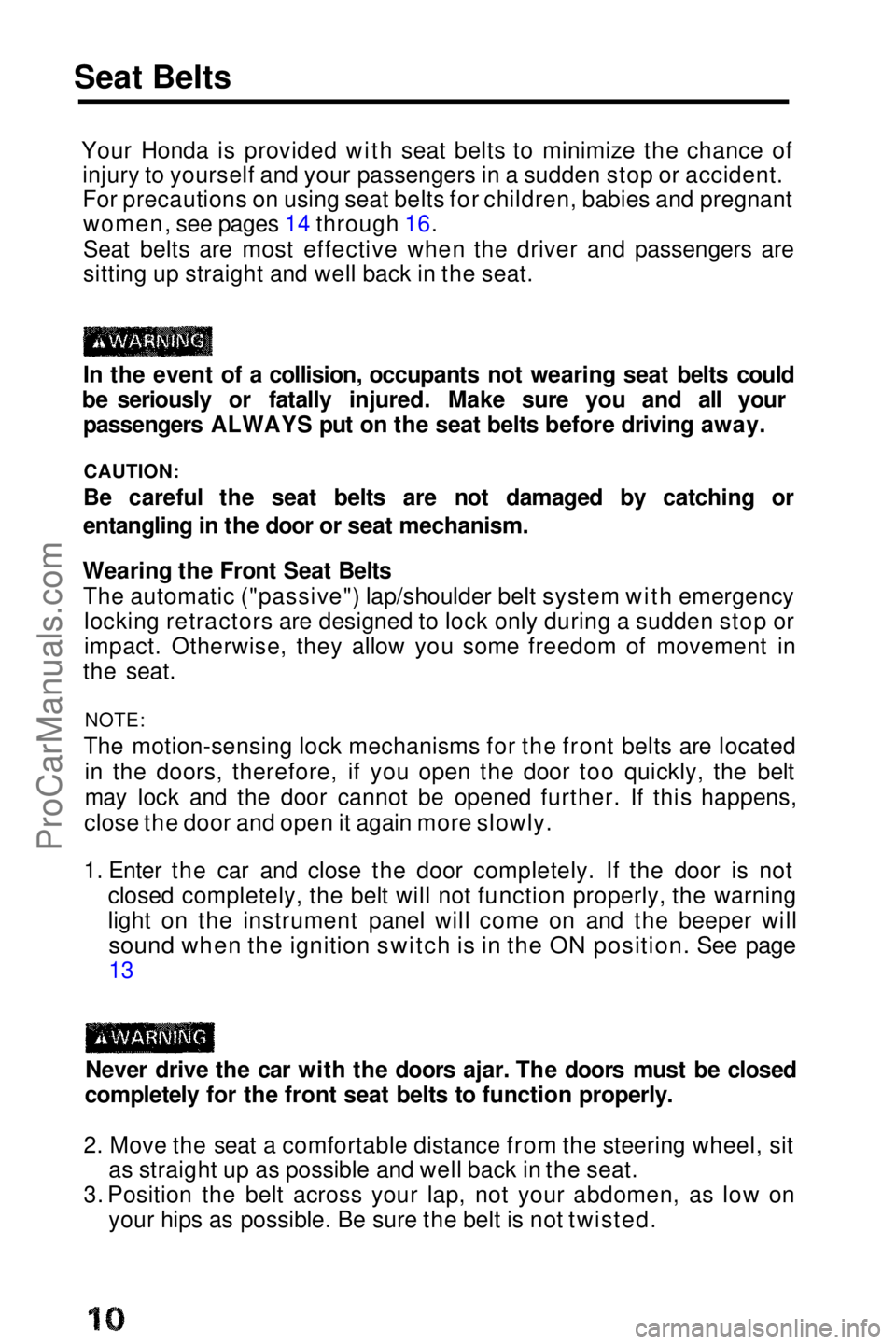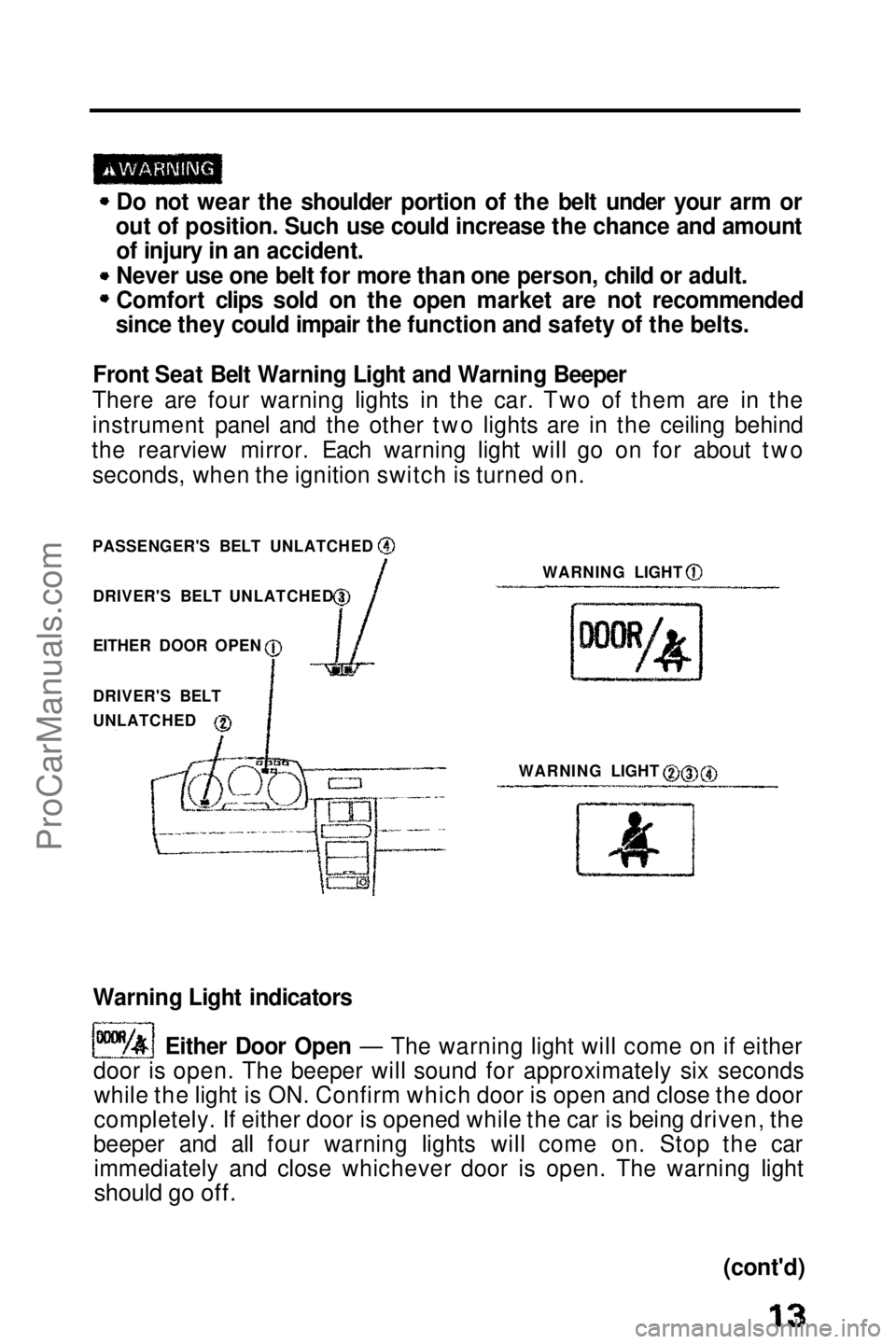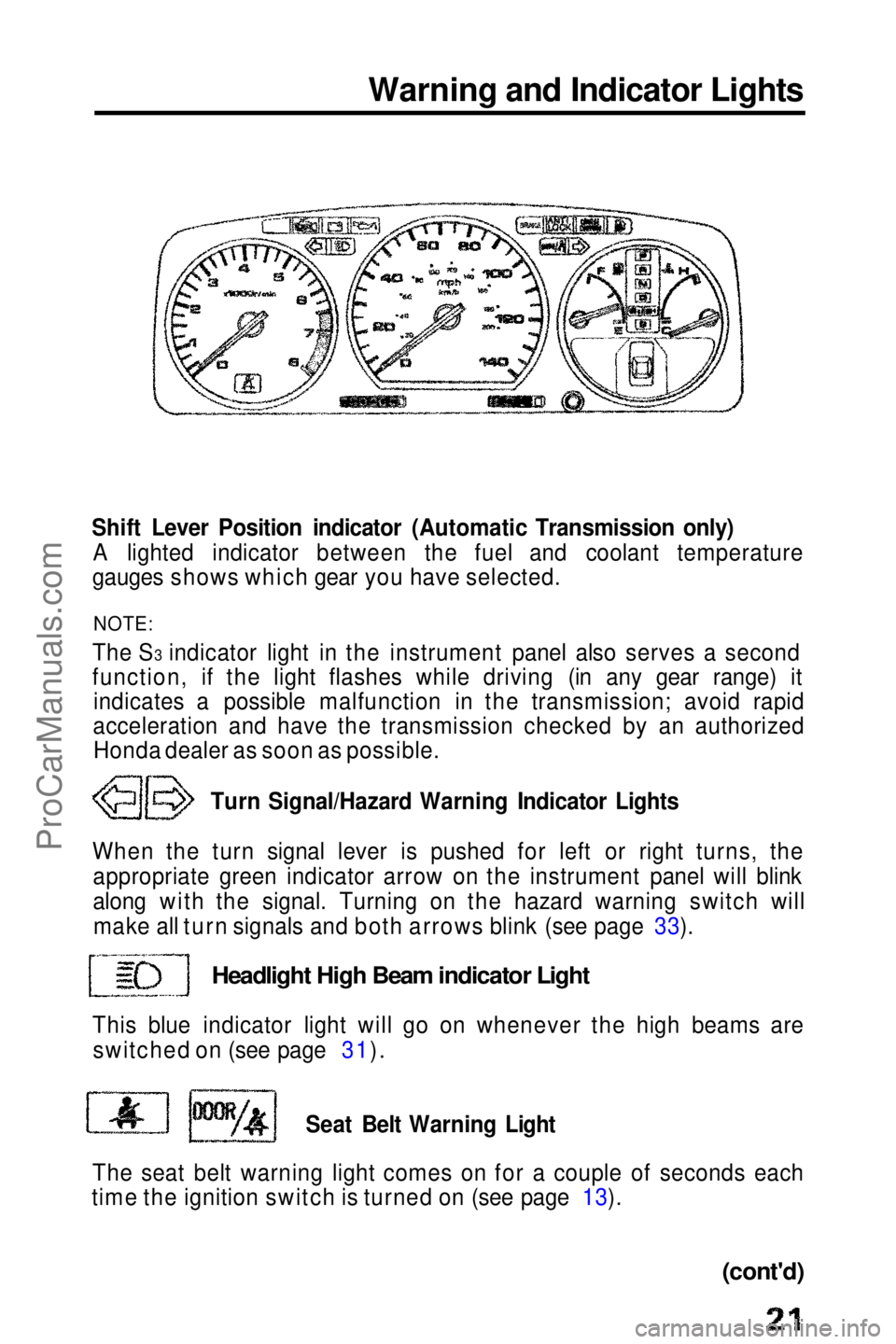1990 HONDA PRELUDE ignition
[x] Cancel search: ignitionPage 3 of 143

Keys and Locks
VALET KEY
MASTER KEY
Keys
Your car is supplied with a master
key that fits the ignition and all locks,
and a valet key that fits the ignition
and doors but not the trunk, rear
seat trunk access or glove box.
The valet key is provided for times
when you must leave the key with a parking attendant or repair person,
but still want to keep valuables
safely locked-up.
Write down the numbers stamped on both keys and keep the information in your wallet or purse in case you ever need to have
duplicates made. Both the master and valet keys are double-edged, so you can insert them in the locks with either side up.
Door Locks
You can lock the doors by pushing the tabs forward.
The doors must be unlocked before you can open them. The passenger door can be locked when open, and will stay locked when
you close it; the driver's door cannot be locked when open unless
you hold the door handle open. Both doors can be locked and
unlocked from the outside with the key.
(cont'd)
Lock
Unlock
ProCarManuals.comMain Menu t s
Page 10 of 143

Seat Belts
Your Honda is provided with seat belts to minimize the chance ofinjury to yourself and your passengers in a sudden stop or accident.
For precautions on using seat belts for children, babies and pregnantwomen, see pages 14 through 16.
Seat belts are most effective when the driver and passengers are
sitting up straight and well back in the seat.
In the event of a collision, occupants not wearing seat belts could
be seriously or fatally injured. Make sure you and all your passengers ALWAYS put on the seat belts before driving away.
CAUTION:
Be careful the seat belts are not damaged by catching or
entangling in the door or seat mechanism.
Wearing the Front Seat Belts The automatic ("passive") lap/shoulder belt system with emergency locking retractors are designed to lock only during a sudden stop or
impact. Otherwise, they allow you some freedom of movement in
the seat.
NOTE:
The motion-sensing lock mechanisms for the front belts are located in the doors, therefore, if you open the door too quickly, the belt
may lock and the door cannot be opened further. If this happens,
close the door and open it again more slowly.
1. Enter the car and close the door completely. If the door is not closed completely, the belt will not function properly, the warning
light on the instrument panel will come on and the beeper will
sound when the ignition switch is in the ON position. See page
13
Never drive the car with the doors ajar. The doors must be closed
completely for the front seat belts to function properly.
2. Move the seat a comfortable distance from the steering wheel, sit as straight up as possible and well back in the seat.
3. Position the belt across your lap, not your abdomen, as low on your hips as possible. Be sure the belt is not twisted.ProCarManuals.comMain Menu t s
Page 13 of 143

Do not wear the shoulder portion of the belt under your arm or
out of position. Such use could increase the chance and amount of injury in an accident.
Never use one belt for more than one person, child or adult.
Comfort clips sold on the open market are not recommended
since they could impair the function and safety of the belts.
Front Seat Belt Warning Light and Warning Beeper
There are four warning lights in the car. Two of them are in the
instrument panel and the other two lights are in the ceiling behind
the rearview mirror. Each warning light will go on for about two seconds, when the ignition switch is turned on.
WARNING LIGHT
WARNING LIGHT
Warning Light indicators Either Door Open — The warning light will come on if either
door is open. The beeper will sound for approximately six seconds while the light is ON. Confirm which door is open and close the door
completely. If either door is opened while the car is being driven, the
beeper and all four warning lights will come on. Stop the car immediately and close whichever door is open. The warning light
should go off.
(cont'd)
PASSENGER'S BELT UNLATCHED
DRIVER'S BELT UNLATCHED
EITHER DOOR OPEN
DRIVER'S BELT
UNLATCHEDProCarManuals.comMain Menu t s
Page 19 of 143

Instrument Panel
TURN SIGNAL/ LIGHT SWITCH/
DIMMER SWITCH
SUNROOFSWITCH
HEADLIGHT
MOTOR
SWITCH PANEL BRIGHTNESS
CONTROL KNOB HAZARD WARNING
LIGHT SWITCH
FOG LAMP
SWITCH REAR WINDOW
DEFOGGER
SWITCH
DIGITAL
CLOCK
CENTER
VENTS
CRUISE
CONTROL
MASTER
SWITCH
FUSE BOX COIN BOX
HORN
BUTTON WINDSHIELD
WIPER/WASHER
SWITCH LEVER
IGNITION SWITCH CIGARETTE
LIGHTER
HEATING/
COOLING
CONTROL
PANEL
TACHOMETER SPEEDOMETER
FUEL GAUGESHIFT LEVER
POSITION
INDICATOR
(AUTOMATIC)
ODOMETER TRIP METER
TRIP METERRESET BUTTON SAFETY
INDICATOR
LIGHT
COOLANT
TEMPERATURE
GAUGEProCarManuals.comMain Menu t s
Page 20 of 143

Speedometer
The speed is indicated in miles per hour (outside scale) and
kilometers per hour (inside).
Odometer
The numbers on the odometer indicate miles.
The odometer registers total distance traveled, and serves as your
guide for determining when periodic maintenance is due. Federal law makes it illegal to alter the odometer of any motor vehicle with the
intent to change the number of miles indicated.
Trip Meter
The numbers on the trip meter indicate miles.
The trip meter can be returned to zero by pushing in the resetbutton. Use it for checking fuel consumption or distance traveled per trip.
Tachometer
The tachometer indicates engine speed in revolutions per minute.The beginning of the RED ZONE indicates the maximum allowable
engine R.P.M. Do not run the engine with the tachometer indicator
needle in the RED ZONE.
Fuel Gauge
FUEL TANK CAPACITY: 60 l (15.9 US gal, 13.2 Imp gal)
As a convenience, the gauge continues to show the same fuel level as when the ignition was last on. After refueling, the gauge will
slowly change to the new fuel level when the ignition is switched on.
When the needle first indicates E (empty), you have a usable reserve left in the tank of about:
4 l
(1.1
US gal, 0,9 Imp gal)
Coolant Temperature GaugeCAUTION:
The needle should stay within the white range. If the needle reaches the red line at "H" (Hot), pull safely off the road, stop the
engine and check the coolant level in the reserve tank on the passenger side of the radiator under the hood.
Do not remove the radiator cap when the engine is hot. The
coolant is under pressure and may blow out and scald you.
GaugesProCarManuals.comMain Menu t s
Page 21 of 143

Warning and Indicator Lights
Shift Lever Position indicator (Automatic Transmission only) A lighted indicator between the fuel and coolant temperature
gauges shows which gear you have selected.
NOTE:
The S3 indicator light in the instrument panel also serves a second
function, if the light flashes while driving (in any gear range) it indicates a possible malfunction in the transmission; avoid rapid
acceleration and have the transmission checked by an authorized Honda dealer as soon as possible.
Turn Signal/Hazard Warning Indicator Lights
When the turn signal lever is pushed for left or right turns, the appropriate green indicator arrow on the instrument panel will blink
along with the signal. Turning on the hazard warning switch willmake all turn signals and both arrows blink (see page 33).
Headlight High Beam indicator Light
This blue indicator light will go on whenever the high beams are switched on (see page 31).
Seat Belt Warning Light
The seat belt warning light comes on for a couple of seconds each
time the ignition switch is turned on (see page 13).
(cont'd)ProCarManuals.comMain Menu t s
Page 22 of 143

Warning and Indicator Lights (cont'd)
Oil Pressure Warning Light
A severe fluctuation in engine oil pressure will cause this light to
flash on and off. You should stop as soon as possible, check the oil level, and add oil if necessary.
The oil pressure warning light will come on, and remain on, if there is insufficient oil pressure or when the ignition switch is turned on
with the engine not running. If the light should stay on while driving,
get the car off the road as soon as you can, turn the engine off and
check the engine oil level (see page 83).
Even if the oil level is correct, the engine should be checked by a
Honda dealer before the car is driven again.
NOTE:
The oil pressure warning light will only light as a result of low oil pressure. It is not directly an oil level indicator.
CAUTION:
Running the engine while the oil pressure warning light is on
constantly may cause immediate and severe engine damage.
Cruise Control Indicator Light
When the cruise control system is on, this indicator light is on (see
page 35 and 36).
Fuel Reserve Warning Light
If the warning light glows, it means you should refuel, because the
tank contains less than:
10 l (2.6 US gal, 2.2 Imp gal) CRUISE
CONTROLProCarManuals.comMain Menu t s
Page 23 of 143

Charging System Warning Light
The charging system warning light comes on when there is a problem with the electrical charging system or when the ignition
switch is turned on with the engine not running. If the light comes
on while driving, stop the car and check to see if the alternator belt is loose or broken.
To check the belt tension, stop the engine and push with about 98N (22 Ib) of force on the middle of the belt as shown. The belt should
deflect about:
10
—
12 mm (0.4
—
0.5 in) If the engine has been running,
some engine components may
be hot enough to burn you. Keep hands away from the
radiator fan. The fan may start
automatically without warning
and run for up to 15 minutes,
even after the engine is turned
off.
NOTE:
If necessary, have the charging system checked by an authorized
Honda dealer.
Check Engine Warning Light
This light comes on for a couple of seconds each time the ignition is
turned on. It will also come on, and remain on, if there is a
malfunction in the emission control system. If the light comes on
while driving, avoid driving at high speed, and have the system checked by a Honda dealer as soon as possible.
Parking Brake/Brake Failure Warning Light
Check the brake warning light every time you start the car.
With the parking brake set, the warning light should go on when the
ignition switch is turned to II or III, With the parking brake released,
the light should go on when the ignition switch is turned to III. If the light goes on at any other time, it means the brake fluid level in the
master cylinder reservoir is too low ; add fluid and have your dealer
check for leaks and brake pad wear immediately. See page 99. BRAKE
(cont'd)ProCarManuals.comMain Menu t s